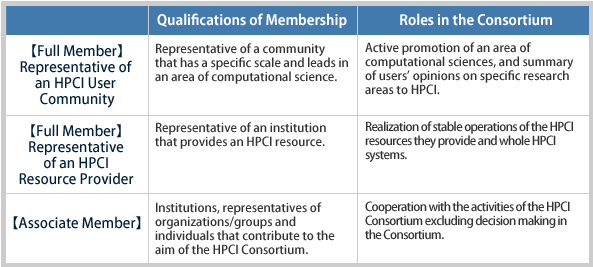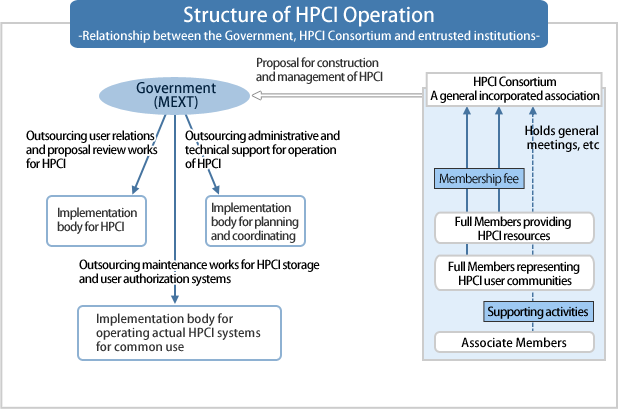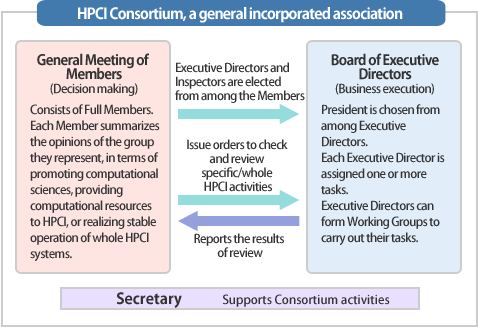

Background to Foundation
The Next-Generation Supercomputer Project was launched in FY2006 and had the following three goals at that time.
- Development and maintenance of the world's most advanced highest-performance next-generation supercomputer
- Development and dissemination of grand challenge applications of nanotechnologies and life sciences to make full use of the next-generation supercomputer
- Establishment of a Center of Excellence (COE) for research and education related to the world's highest-level supercomputing with the next-generation supercomputer as a core
In the budget screening process by the Government Revitalization Unit on 13 November 2009, fierce criticism was made of the Next-Generation Supercomputer Project from the viewpoint of its purpose and insufficient explanation to the general public, raising various opinions from many people. Eventually, the Project was renamed the High-Performance Computing Infrastructure (HPCI) Project, which aims to establish an innovative HPCI, and its continuation was approved with the agreement of four ministers on 16 December 2009.
The HPCI Project aims to establish an HPCI, which will be centered around the next-generation supercomputer, the K computer, and realize an innovative computing environment to meet various requirements from users, and to promote the use of the HPCI. This Project has two missions. One is the establishment of the HPCI system, which will connect nationwide HPC resources with the K computer as the core. The other is the establishment of the HPCI Consortium, which will integrate communities related to computational science and technology, and the development and operation of the HPCI under the Consortium.
In April 2010, the HPCI Review Working Group was set up under the then Vice-Minister Masaharu Nakagawa of the Ministry of Education, Culture, Sports, Science and Technology (MEXT) and was assigned to prepare the grand design of the HPCI system and Consortium as a community based on computational science and technology. In May 2010, the Working Group collated the review results and published the report "Grand Design of HPCI System and Consortium Playing a Leading Role in Development of the System" (26 May 2010). Thirty-eight organizations were recruited by MEXT, and the Preparatory HPCI Consortium was established in July 2010 on the basis of the report. The Preparatory HPCI Consortium examined various issues, including (1) the missions of the HPCI Consortium, (2) the vision of the HPCI system and the selection of the research themes, and (3) the promotion of industrial applications and user support. The results of the examination were complied into a final report "Vision of HPCI System and Consortium Playing a Leading Role in Development of the System" (30 January 2012) and submitted to the government as a recommendation.
With the above background, the General Incorporated Association HPCI Consortium was founded in April 2012. The first General Meeting was held in June 2012.
Outline of HPCI Consortium
The philosophies of the HPCI Consortium are as follows.
- It is open to all persons and organizations related to computational science and technology (communities related to computational science and technology).
- To take the initiative in developing computational science and technology, develop the world's highest-performance technologies, and apply the technologies to society in cooperation with related organizations.
The HPCI Consortium aims to establish a responsible management system in the form of a general incorporated association. The Consortium consists of full and associate members and is supported by the membership fees from full members.
Membership options are defined as follows.
- A general incorporated association, which is independent and not financially supported by the Government
- Consists of Full Members, each of whom represents an HPCI user community or an HPCI resource provider, and Associate Members

The HPCI Consortium summarizes opinions regarding the following issues from various communities related to computational science and technology, promotes the implementation of approaches to these issues, and gives recommendations to the government and related organizations with the aim of realizing the approaches.
- Maintenance and operation of HPCI system
- Development of computational science and technology
- Future supercomputing
Basic guidelines for maintaining and operating HPCI system
Basic guidelines for selecting research themes and supporting users
Investigation of current status of maintenance and operation and summarization of requests to government
Basic guidelines for effectively using and maintaining nationwide computing resources in Japan
Development and expansion of computational science and technology and applied techniques
Creation of new fields and communities
Development of human resources
Collaboration with related overseas organizations
The relationship between the above missions and the promotion of the HPCI Project by the government is shown in the figure below.

The HPCI Consortium is managed at the General Meeting and by the Board of Executive Directors.
The General Meeting consists of all full members, who have a right to vote on decisions of the Consortium. Associate members have no right to vote but are eligible to attend and offer an opinion at the General Meeting.
The Board of Executive Directors consists of executive directors appointed at the General Meeting. The President and Vice-President are appointed on the basis of the recommendation at the General Meeting. The Executive Board executes tasks determined at the General Meeting.

